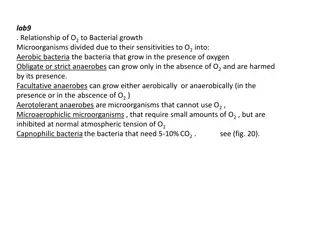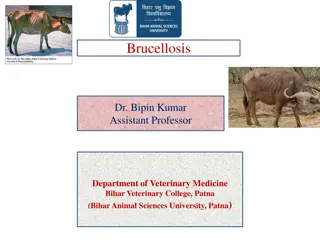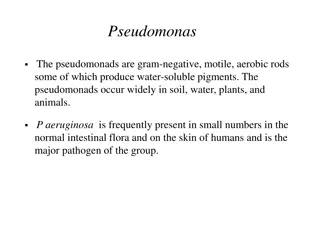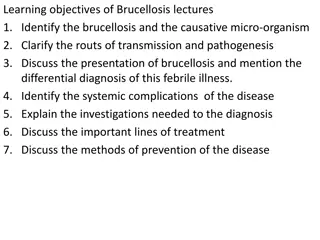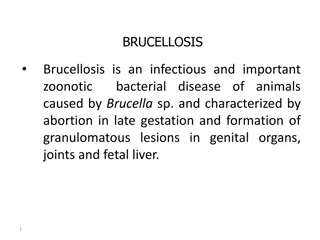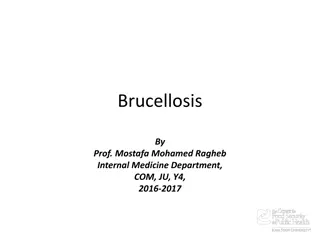Overview of Brucella Bacteria and Brucellosis Infection
Brucella bacteria are Gram-negative coccobacilli associated with Brucellosis, a disease causing flu-like symptoms in humans. They exhibit specific characteristics, differential tests, and antigenic structures. Infection occurs through various sources like milk, meat, and contact with infected animals. Different Brucella species vary in their virulence to humans, with Br. melitensis being the most pathogenic. Understanding these aspects is crucial for preventing and managing Brucellosis infections.
Download Presentation

Please find below an Image/Link to download the presentation.
The content on the website is provided AS IS for your information and personal use only. It may not be sold, licensed, or shared on other websites without obtaining consent from the author.If you encounter any issues during the download, it is possible that the publisher has removed the file from their server.
You are allowed to download the files provided on this website for personal or commercial use, subject to the condition that they are used lawfully. All files are the property of their respective owners.
The content on the website is provided AS IS for your information and personal use only. It may not be sold, licensed, or shared on other websites without obtaining consent from the author.
E N D
Presentation Transcript
Brucellae It is the causative agents of Brucellosis(also called undulant fever or Malta fever, or Bangs disease). * David Bruce (1889) isolated Br.meletensis from the spleen of a British soldier stationed in Malta. * Bang (1897) in Denmark, discovered Br.abortus from cows suffering from infectious abortion. * Traum (1914) isolated Br.suis from the fetus of a saw (pig female).
General Characteristics: - They are Gram ve, short and slender coccobacilli, 0.8-1.5 X 0.5-0.7M. , non spore forming, non motile, but capsulated in the smooth forms. - Aerobic, but abortus species prefer CO2 for growth. - Grow best on media enriched with animal protein, such as: serum, liver extract agar or serum dextrose agar. - They show S and R variation. Viability : * They are killed at 600C in 10 minutes, and by 1% phenol in 15min. * They survive in agar at 00C for 1 month or more. * Acid protection leads to its death in cheese and butter. * In Bovine feces, in dark, may survive for 4 months.
Brucellae Differential test for Brucella: Character and biochemical test 1 Usual reservoir Br.melete nsis Sheep&g oat - Br.abort us cattle Br.suis Pig 2 5-10% CO2 requirement 3 H2S production 4 Predominant antigen 5 Urease activity (in minutes) 6 Phage sensitivity TB(T bacilli) + - - + A -or + A 15-30 M variable 120 or more + - -
Ag structure : They posses two similar heat stable O antigenic consistent A & M, which are present in different proportions in species:- Br.abortus, A:M = 20:1 ,While in Br.suis & Br.meletesis is 1:20.
Infection: Mode of infection is by ingestion, inhalation, contact, skin, conjunctiva or by accident inoculation. * Source of infection: milk or milk products, meat, vaginal discharge of animals, fetuses, urine or animal excreta, contaminated raw vegetables and fruits etc. * Presence of erythritol in animal placenta stimulates the growth of virulent
*Brucella * Human placental tissue does not contain erythritol. * In most cases of animal infection, they excrete the organisms freely in the uterine discharges, in feces, in urine .etc. * The organism may localize in the mammary glands and excreted with milk, which is the main source of human infection. * In pigs, Br.suis rarely involves the mammary glands. * Virulence to human, Br. melitensis comes first, then Br. Suis then Br. abortus.
Laboratory Diagnosis A- Direct fluorescent microscopy: which is performed by labeling the antiserum with fluorescent dye and mixed with the infected human clinical material. B-Blood culture: - It is important in the acute phase of the infection. - It should be carried out repeatedly because the organisms may enter the blood intermittently. - It is +ve in only 30-50% of cases, mainly in the first 2- 3 weeks of the disease, and become ve when patient develop agglutinins, C.F. antibodies, and opsonins. - It is +ve during relapse, although antibodies are found in high titer.
Laboratory Diagnosis C- Serological agglutination reaction : - Show +ve results after 8-10days with titer of 1/160 or more. - Smooth form of Brucella should be used as antigens. - In chronic Brucellosis, antibodies may falls or even become absent; although patient are still show symptoms of the disease. - Complete absence of agglutination does not mean there is no infection. - As the disease progresses from acute to chronic form, the organisms become localized intracellularly in various parts of the body, therefore, IgM (detected in acute stage) decreases, and agglutination titer falls then finally become absent. - If the infection continues, IgG could be detected by C.F. tests. Cross-reactions were found to occur with persons immunized against Cholera and Francisella tolerance -
Laboratory Diagnosis Rose bengal antigens (stained red). The significant titre = 1/160 or higher. Cross reaction may occur with cholera vaccine, S.typhi /paratyphi , or Yersinia . Skin test using heat killed bacteria or their extract (Brucellin or Brucellergin)give+ve test in 3-6 weeks of the disease due to the production of delayed type of hypersensitivity, but +ve reaction indicates past or present infection. - - Treatment: The drug of choice is tetracycline+ Rifampin.
Types of Clinical Manifestation 1-Latent infection: - Can be detected only by serological methods, usually seen in persons who are directly come in contact with infected animals. 2-Acute infection: - May begins suddenly after an incubation period of 10-14 days or more characterized by daily diurnal remitting fever with chills. - Involvement of the RES leads to enlargement of the lymph nodes, spleen and liver.
Types of Clinical Manifestation 3-Chronic low grade infection: - This show periodic relapses which may last 1-20 years. - Patient suffer from, joint pains, sweating, weakness, insomnia, while pyrexia may be absent or slight. - Organisms are rarely isolated from blood, because they grow intracellularly in red cells producing granulomatous tissue reactions. - Spontaneous recovery may occur due to development of the cellular immunity similar to that found in tuberculosis.






